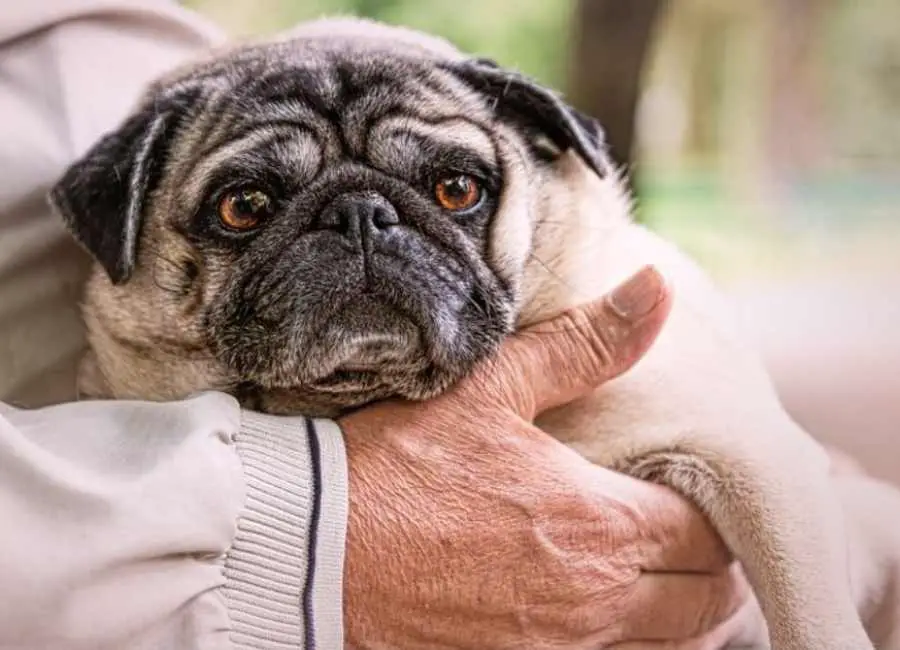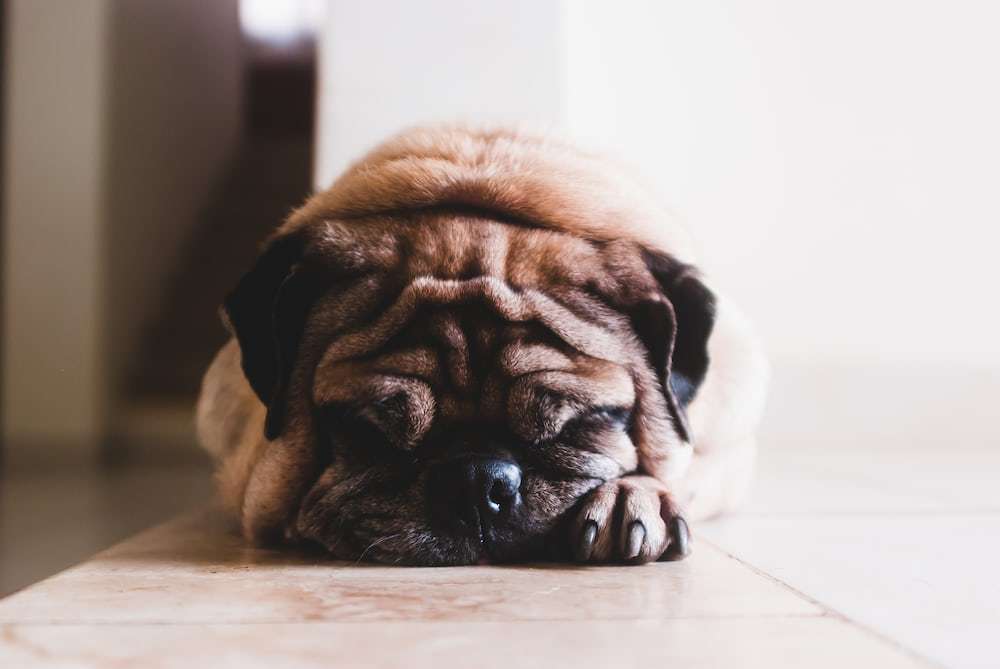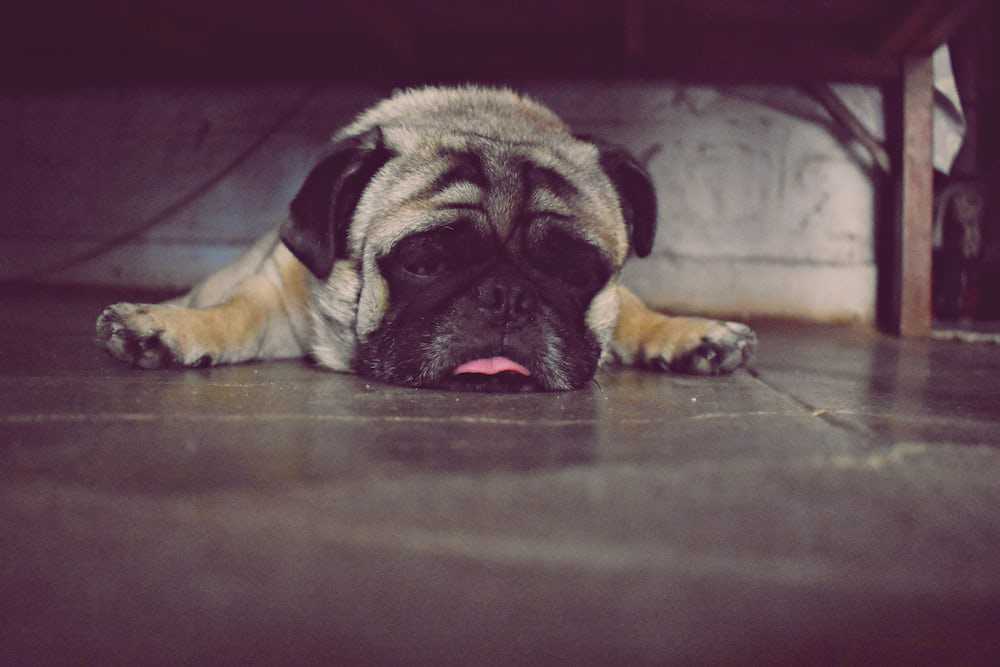12 Senior Pugs Problems & Care

This article is focused on discussing senior Pugs care and problems you should know and expect, so keep reading.
Pugs are a loveable breed, and they’re great for owners who want to spend the day with their dogs. However, senior pugs can also be prone to serious health problems as they age.
What are Senior Pugs
“Senior Pugs” likely refers to older pugs, which are a breed of small dogs known for their distinctive wrinkled faces and curly tails.
“Senior” in this context indicates that these pugs are in the later stages of their life, typically around 7 years or older.
Just like with humans, senior dogs may require special care and attention due to age-related health concerns.
How to Care for Senior Pugs

Senior pugs require special care to ensure their health and well-being. Here are some common ways to care for senior pugs:
- Regular Veterinary Check-ups: It’s important to schedule regular check-ups with a veterinarian who can monitor their overall health and address any potential issues.
- Proper Nutrition: Senior pugs may have different dietary needs, so it’s important to provide them with a balanced and age-appropriate diet. Consult with a veterinarian to determine the best food options for your senior pug.
- Weight Management: Obesity can lead to various health problems in senior pugs, so it’s essential to monitor their weight and maintain a healthy body condition. Ensure they receive enough exercise and portion control their meals.
- Exercise: Although they may not be as active as they once were, senior pugs still benefit from regular exercise to keep them mentally stimulated and prevent weight gain. Tailor their exercise routine to their energy levels and physical capabilities.
- Dental Care: Dental issues, such as tooth decay and gum disease, are common among senior pugs. Regular tooth brushing and annual dental cleanings can help maintain their oral health and prevent pain and discomfort.
- Joint Health: As pugs age, they may develop joint problems like arthritis. Provide them with joint supplements, such as glucosamine and chondroitin, under veterinary guidance to support their joint health and mobility.
- Eye Care: Pugs are prone to eye problems, including cataracts, as they age. Regularly clean their eyes and consult with a veterinarian if you notice any signs of eye discomfort or vision changes.
- Mental Stimulation: Keep your senior pug mentally stimulated through interactive toys, puzzles, and regular social interactions. This helps prevent cognitive decline and keeps them engaged.
- Comfort and Safety: Create a comfortable environment for your senior pug by providing them with a soft and orthopedic bed. Ensure their living space is safe, free from hazards, and easily accessible.
Remember, every senior pug is unique, and their care needs may vary. It’s crucial to consult with a veterinarian who can provide personalized guidance based on your specific pug’s health and needs.
Pug Old Age problems

Here are some common pug old age problems you should know:
1. Arthritis and Joint Pain
Aging Pugs are susceptible to arthritis due to the wear and tear their joints endure over the years. Cartilage in the joints can erode, causing discomfort and limited mobility. Investing in an orthopedic bed provides crucial support for their joints and cushions their body.
Supplements containing glucosamine, chondroitin, and omega-3 fatty acids can alleviate inflammation and promote joint health. Consult your veterinarian to determine the appropriate dosage. Moreover, controlled exercise is vital.
Short, leisurely walks on soft surfaces or swimming can keep their joints active without straining them. Implementing ramps or stairs for them to climb onto furniture can also minimize joint stress.
2. Dental Problems
Dental hygiene is paramount for senior Pugs, as they are prone to gum disease and tooth decay. Regular brushing, ideally daily, with a dog-friendly toothpaste prevents plaque buildup and maintains healthy gums. Dental treats and chews are not only a tasty indulgence but also help remove tartar and massage the gums.
Annual dental checkups by a vet are essential to identify any potential issues early on. Professional cleanings might be recommended to prevent the progression of dental problems that can impact their overall health.
3. Obesity
Senior Pugs tend to be less active, which can lead to weight gain and exacerbate other health problems. Opt for a high-quality, age-appropriate dog food that’s lower in calories but rich in nutrients. Portion control is crucial; consult your vet to determine the correct amount of food based on their size and activity level.
To encourage physical activity, engage them in low-impact exercises like short walks or gentle play sessions. Keeping them mentally stimulated with puzzle toys or interactive games can also prevent overeating due to boredom.
4. Respiratory Issues
Pugs’ flat faces contribute to their susceptibility to respiratory problems. They struggle to regulate body temperature and may have difficulty breathing, especially in extreme heat or cold. Maintain a comfortable indoor temperature and provide plenty of water to prevent dehydration.
Using a harness during walks instead of a collar prevents unnecessary pressure on their delicate neck and throat, which can obstruct their airways. Be cautious when exercising them in hot weather, opting for cooler times of the day.
5. Eye Problems
Pugs are prone to a variety of eye conditions as they grow older due to their prominent eyes. Regular eye care involves gently cleaning their eyes with a damp, soft cloth to remove any discharge and prevent infections.
Use veterinarian-recommended eye drops to combat dryness and maintain ocular health. Cloudiness, redness, or changes in their eyesight should prompt an immediate visit to the vet to prevent further complications.
6. Skin Allergies
Aging Pugs might develop skin sensitivities, causing itchiness, redness, or rashes. Opt for hypoallergenic grooming products and a mild, moisturizing shampoo to keep their skin healthy.
Regular grooming sessions not only maintain skin health but also provide an opportunity to inspect for any unusual growth or skin changes. Consult your vet if you notice persistent scratching or skin issues, as they can recommend specialized shampoos or treatments.
7. Hearing Loss
Gradual hearing loss is common in aging Pugs. Communicate with them using visual cues, hand signals, and facial expressions.
Training may take a bit more patience and repetition. Keep them safe by avoiding situations where they might be startled due to their reduced ability to hear approaching sounds.
Learn more about caring for pug ears.
8. Cognitive Dysfunction
Canine cognitive dysfunction (CCD) is akin to dementia in humans and can lead to confusion and anxiety. Mental stimulation is crucial to keep their minds active.
Interactive toys, treat-dispensing puzzles, and regular training sessions engage their cognitive abilities. Establishing a consistent daily routine provides them with a sense of security, reducing stress associated with cognitive decline.
9. Heart Conditions
Pugs are genetically predisposed to heart issues, particularly mitral valve disease. Regular checkups, including cardiac assessments, help monitor their heart health.
Medications prescribed by your vet can manage heart conditions and improve their quality of life. Maintaining a healthy weight through proper diet and light exercise supports their cardiovascular well-being.
10. Diabetes
Obesity and genetics increase the risk of diabetes in senior Pugs. A balanced, high-fiber diet that helps regulate blood sugar levels is essential. Portion control is vital, and your vet can guide you on feeding guidelines.
Regularly monitor their weight and blood sugar levels, and be vigilant for signs such as increased thirst, frequent urination, and sudden weight loss. If diagnosed, your vet will design a comprehensive management plan involving diet, medication, and monitoring.
11. Cancer
Cancer is a concerning health issue that can affect aging Pugs. Regularly examine your Pug’s body, feeling for any unusual lumps, bumps, or changes in texture. Monitor their behavior and appetite; any sudden shifts can indicate underlying health problems.
Promptly consult your vet if you notice anything amiss. Early detection through regular checkups and attentive observation significantly improves the chances of successful treatment.
12. Incontinence
Bladder control can be a concern for aging pugs. They may experience urinary incontinence, which can lead to accidents indoors. Provide frequent potty breaks to accommodate their needs.
Use pee pads or doggy diapers to manage accidents and protect your home. Consult your vet to rule out any underlying medical conditions that could contribute to incontinence.
Learn more about pug health problems.
Related Questions
What age is considered ‘senior’ for a Pug?
Typically, Pugs are considered ‘senior’ when they reach around 7 to 9 years of age. However, this may vary depending on the individual dog’s health and overall condition.
How do I know if my Pug is entering their senior year?
Just like humans, Pugs may start showing signs of aging as they enter their senior years. Look out for symptoms such as decreased energy levels, slower movements, joint stiffness, and changes in appetite. Regular vet check-ups can also help monitor your Pug’s health.
What are some common health issues that senior Pugs can face?
Senior Pugs are prone to certain health conditions such as arthritis, obesity, dental problems, respiratory issues, and vision or hearing loss. Regular vet visits and a well-balanced diet can help manage these issues and keep your Pug happy and healthy.
Do senior Pugs require different care compared to younger Pugs?
Yes, senior Pugs often require some adjustments in their care routine. They may benefit from a lower-impact exercise routine, joint supplements to support their mobility, and a diet tailored to their age and specific needs. Mental stimulation and regular veterinary check-ups are also important for their overall well-being.
How can I best support my senior Pug’s overall health?
To support your senior Pug’s health, ensure they have a nutritious diet, provide them with regular exercise suitable for their age and abilities, maintain their oral hygiene, and keep their weight in check. Regular vet check-ups are crucial for early detection and management of any age-related health issues.
Are senior Pugs still playful and affectionate?
Absolutely! While their energy levels might decrease slightly, senior Pugs can still be playful, loving, and affectionate companions. They may not have the same level of endurance as when they were younger, but with proper care, they can enjoy a happy and fulfilling life well into their golden years.
Learn more about causes of death in pugs.
Conclusion
In conclusion, senior pugs are absolute gems that deserve all the love and care in the world. From their graying muzzles to their gentle snores, these furballs bring an undeniable charm to our lives. As our loyal companions grow older, it’s crucial that we prioritize their health and happiness.
Whether it’s providing them with a balanced diet, regular exercise, or those much-needed cuddle sessions, let’s give our senior pugs the golden years they truly deserve. So, let’s celebrate the wisdom and sweetness of our senior pugs and treasure every moment we have with them. They truly are the epitome of unconditional love!
Learn more about signs your pug is dying and pug sick symptoms.
